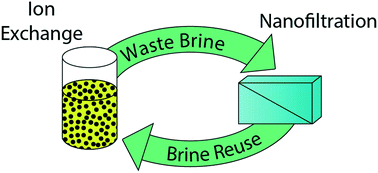Decreasing waste brine volume from anion exchange with nanofiltration: implications for multiple treatment cycles†
Abstract
Ion exchange (IX) is a technology for removing hexavalent chromium from water, but waste brine disposal makes implementation cost prohibitive in many communities. Nanofiltration (NF) can be integrated to decrease the waste brine volume by 70% and reuse the permeate (NF-reuse) as brine in the next IX regeneration. However, the accumulation of impurities and resulting impact on IX regeneration and loading efficiency have not been evaluated through comparative mass balances or post-regeneration batch tests. Combining pilot-scale experiments with response surface modeling, impurities in waste brine are predicted to reach a pseudo steady state over 10 loading–regeneration–NF-reuse cycles, simulating long-term operation at full-scale facilities. Side-by-side regenerations show that NF-reuse brine does not impact the IX regeneration efficiency of chromium, sulfate or inorganic carbon. Regeneration efficiency increases for vanadium and uranium by 30–60% using the NF-reuse brine, which may decrease long-term fouling and reduce the frequency for strong acid regenerations. With NF-reuse, additional nitrate loads onto the IX resin during regeneration, which may impact the timing and magnitude of chromatographic peaking. During loading, arsenic exhibited chromatographic peaking at concentrations 220% higher than the influent concentration, exceeding regulatory thresholds under all regeneration scenarios. Arsenic leakage also occurred during the first 500 bed volumes with NF-reuse. Vanadium and chromium both exhibited faster breakthrough in the second loading cycle, demonstrating the importance of evaluating pilot-scale processes over multiple loading and regeneration cycles. Bench-scale studies need to be guided by full-scale IX operating constraints and evaluate factors beyond the contaminant of concern to fully identify potential impacts of implementing NF brine management. A supplemental spreadsheet is included for utilities to screen NF for system-specific testing.



 Please wait while we load your content...
Please wait while we load your content...